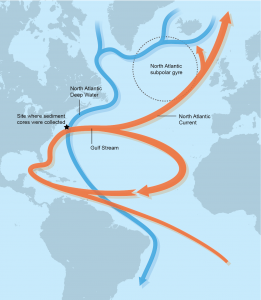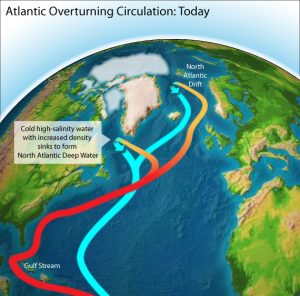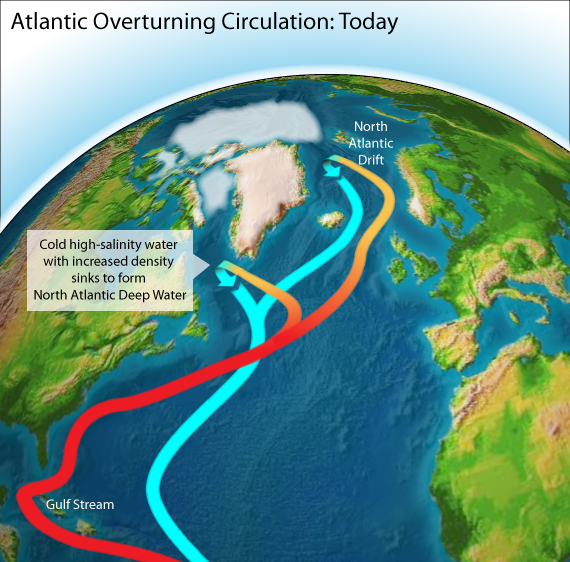Citations:
Caesar et al. Observed fingerprint of a weakening Atlantic Ocean overturning circulation. Nature 556: 191-198. https://doi.org/10.1038/s41586-018-0006-5
Thornalley et al. Anomalously weak Labrador Sea convection and Atlantic overturning during the last 150 years. Nature 556: 227-232. doi:10.1038/s41586-018-0007-4
The science behind the headlines
In April, two papers were published in the prestigious scientific journal Nature that caught the eye of both popular media outlets and the scientific community at large, for good reason; both papers dropped a similar scientific bombshell, suggesting that large-scale circulation in the Atlantic is slower than it has been for the last 1,000 years, at least. Covered in the Washington Post, The Independent, NPR, and beyond, the two research studies use different lines of evidence to come to this similar conclusion, with lots of unknowns yet to explore.
First things first…what is Atlantic meridional overturning circulation?
Atlantic meridional overturning circulation, or AMOC for short, is the ocean equivalent of a conveyor belt; you may also see this referred to as thermohaline circulation, or THC. This system of currents moves heat and water from tropical Atlantic latitudes towards northern Atlantic latitudes, moving around ~ ¼ of the planet’s available heat (Fig. 1).

This conveyor belt perpetuates itself and prevents the pile-up of water in northern latitudes by relying on density-driven water movement. Salty, dense water flowing north cools very rapidly when exposed to cold, windy conditions off the coast of Greenland, in the Labrador Sea, and in the Norwegian Sea, so it sinks, becoming North Atlantic Deep Water (Fig. 2).

This sinking process requires the perfect combination of very salty water and super cool conditions. While many high latitude areas meet the cold requirements, few spots meet the salty/dense criteria, restricting this deep water formation to a few special regions around the globe (Fig. 3).

AMOC is key to regulating temperature and productivity in the Atlantic and around the globe. This circulation keeps Western Europe warm, supports the productive and commercially important fisheries across the northern Atlantic, mitigates US East Coast sea level, and overall acts in regulating global climate. Geological evidence has suggested that when this circulation stops or rapidly slows down (which it has in the past), dramatic changes occur regionally and globally, drastically cooling the North Atlantic and causing variable changes in precipitation, sea level rise, productivity, and temperature around the globe. The 2004 movie The Day After Tomorrow explored the possibilities of catastrophic weather changes that could come with a shutdown of AMOC; while probably not realistic, the ramifications of an AMOC slowdown or shutdown are not something humans want to explore or trigger.
Back to the bombshell studies…
The two studies in Nature both point to big, recent changes in this important circulation system. One study reconstructed deep water current speeds in the Labrador Sea using sediment cores, while also reconstructing temperature and salinity using isotope ratios found in phytoplankton deposits found in sediment. They reasoned that faster currents translated to transport of larger sediment particles, meaning they could comment on AMOC speed by reconstructing current flow using this line of evidence, while using the foraminifera deposits to approximate temperature and salinity as a secondary line of evidence. Using these two lines of ingenious reasoning, this study suggests that the AMOC has been slow since about 1850 compared to the preceding 1500 years, possibly precipitated by glacial melt, with no apparent recovery either due to hysteresis, the dependence of the system on its own history, or continued ice sheet melt due to recent human-caused climate change.
The other study reasoned that decreased AMOC circulation is indicated by cooling in the subpolar Atlantic and warming in the Gulf Stream region. They used Sea Surface Temperature (SST) measurements since 1870 and a rigorous, complex climate model (the CMIP5) to reconstruct the history of AMOC strength from 1870-2016 and see if they could identify this characteristic AMOC slowdown fingerprint. They also compared their AMOC index to direct measurements of circulation taken over the past two decades via the RAPID program. They found that the AMOC has slowed down by about 15% since the mid-20th century, according to both the model projections including carbon dioxide forcing and SST trends measured over time.
What does this actually mean?
You may be asking at this point: why don’t the two studies perfectly align in terms of their conclusions? One study suggests AMOC slowdown has been going on for over 150 years, while the other suggests AMOC slowdown has been particularly noticeable since about 1960.
Answer: that’s science. The two groups used different lines of evidence and contrasted different time periods, meaning their conclusions offer perspectives that are valid at different time scales. It’s important to note that these variable findings aren’t mutually exclusive or negating in any way; both groups broadly converged on the conclusion that AMOC is flagging. The groups both note that continued research is needed to figure out what this observed AMOC slowdown means, how these conclusions fit together, and how human greenhouse gas emissions and global warming could be playing a role in this circulation puzzle.
Overall, the two studies highlight our continued need for climate research at the ocean-scale; we rely on consistent circulation and climate patterns, and yet we still have a lot to figure out about the complex ocean-climate system. We are also massively altering the world around us via greenhouse gas emissions and other pollution, and it’s important to understand what type of changes we could be causing so we can best prepare for the effects or, better yet, change our behavior.
For more about AMOC circulation, head to the RAPID program website, or check out this article and others on Skeptical Science
I am a third year PhD student at the University of Rhode Island Graduate School of Oceanography in the Lohmann Lab. My current research interests include environmental chemistry, water quality, as well as coastal and seabird ecology. When not in the lab, I enjoy diving, surfing, and hanging out with my dog Gypsy.

